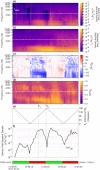Jupiter's Low-Altitude Auroral Zones: Fields, Particles, Plasma Waves, and Density Depletions
- PMID: 36247326
- PMCID: PMC9539694
- DOI: 10.1029/2022JA030334
Jupiter's Low-Altitude Auroral Zones: Fields, Particles, Plasma Waves, and Density Depletions
Abstract
The Juno spacecraft's polar orbits have enabled direct sampling of Jupiter's low-altitude auroral field lines. While various data sets have identified unique features over Jupiter's main aurora, they are yet to be analyzed altogether to determine how they can be reconciled and fit into the bigger picture of Jupiter's auroral generation mechanisms. Jupiter's main aurora has been classified into distinct "zones", based on repeatable signatures found in energetic electron and proton spectra. We combine fields, particles, and plasma wave data sets to analyze Zone-I and Zone-II, which are suggested to carry upward and downward field-aligned currents, respectively. We find Zone-I to have well-defined boundaries across all data sets. H+ and/or H3 + cyclotron waves are commonly observed in Zone-I in the presence of energetic upward H+ beams and downward energetic electron beams. Zone-II, on the other hand, does not have a clear poleward boundary with the polar cap, and its signatures are more sporadic. Large-amplitude solitary waves, which are reminiscent of those ubiquitous in Earth's downward current region, are a key feature of Zone-II. Alfvénic fluctuations are most prominent in the diffuse aurora and are repeatedly found to diminish in Zone-I and Zone-II, likely due to dissipation, at higher altitudes, to energize auroral electrons. Finally, we identify significant electron density depletions, by up to 2 orders of magnitude, in Zone-I, and discuss their important implications for the development of parallel potentials, Alfvénic dissipation, and radio wave generation.
Keywords: Juno; Jupiter; aurora.
© 2022. The Authors.
Figures











References
-
- Allegrini, F. , Bagenal, F. , Bolton, S. , Connerney, J. , Clark, G. , Ebert, R. W. , et al. (2017). Electron beams and loss cones in the auroral regions of Jupiter. Geophysical Research Letters, 44(14), 7131–7139. 10.1002/2017GL073180 - DOI
-
- Allegrini, F. , Mauk, B. , Clark, G. , Gladstone, G. R. , Hue, V. , Kurth, W. S. , et al. (2020). Energy flux and characteristic energy of electrons over Jupiter's main auroral emission. Journal of Geophysical Research: Space Physics, 125(4). 10.1029/2019JA027693 - DOI
-
- Allegrini, F. , Kurth, W. S. , Elliott, S. S. , Saur, J. , Livadiotis, G. , Nicolaou, G. , et al. (2021). Electron partial density and temperature over Jupiter’s main auroral emission using Juno observations. Journal of Geophysical Research: Space Physics, 126(9), e2021JA029426. 10.1029/2021JA029426 - DOI
-
- André, M. , Norqvist, P. , Andersson, L. , Eliasson, L. , Eriksson, A. I. , Blomberg, L. , et al. (1998). Ion energization mechanisms at 1700 km in the auroral region. Journal of Geophysical Research, 103, A3. 10.1029/97JA00855 - DOI
-
- Bader, A. , Badman, S. V. , Ray, L. C. , Paranicas, C. P. , Lorch, C. T. S. , Clark, G. , et al. (2020). Energetic particle signatures above Saturn’s aurorae. Journal of Geophysical Research: Space Physics, 125(1), e2019JA027403. 10.1029/2019JA027403 - DOI
LinkOut - more resources
Full Text Sources
Miscellaneous
